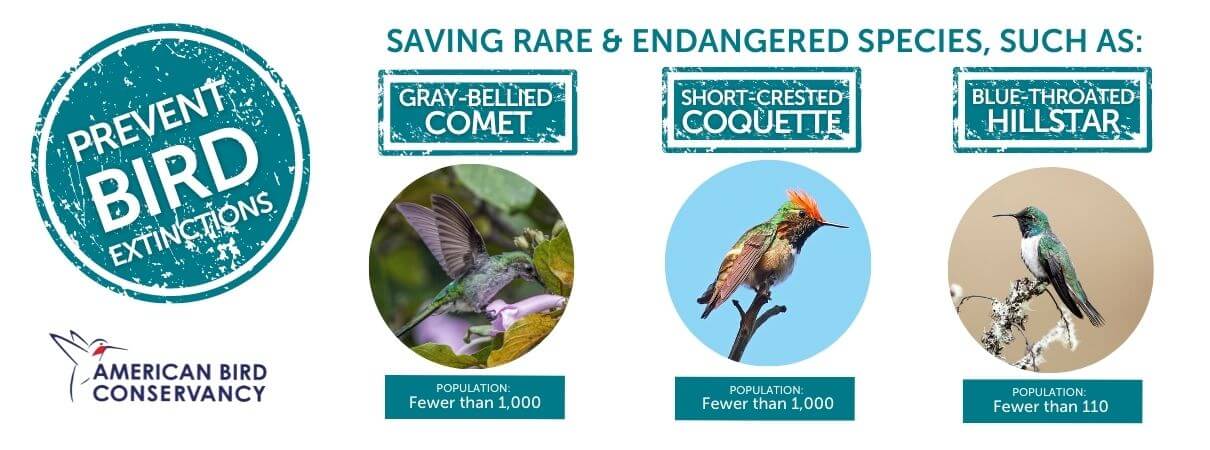As Extinction Risk Escalates, American Bird Conservancy Launches Emergency Fund to Save the Rarest Bird Species

(July 28, 2022) Dozens of bird species hover on the brink of extinction, requiring bold and immediate conservation action to ensure their survival. To help channel support to the species with the most dire need, American Bird Conservancy (ABC) announces the “Preventing Bird Extinctions Fund.” This fund earmarks donations to programs that help save species at the top of ABC's bird conservation framework, or “conservation pyramid,” such as the Kiwikiu and Newell's Shearwater (‘A‘o) in Hawai‘i and the Gray-bellied Comet in Peru.
Species extinction rates are accelerating across the globe. In the Americas and U.S. Pacific Territories alone, 20 bird species have gone extinct in the wild since 1968. And just last year, the U.S. Fish and Wildlife Service proposed taking 11 bird species off of the Endangered Species list due to extinction — eight from Hawai‘i alone.
Many more are in danger of the same fate: 263 bird species in the Americas and U.S. Pacific Territories are listed as Endangered or Critically Endangered on the IUCN Red List — the two highest threat levels. This is part of a larger troubling trend. Globally, an estimated one million animal and plant species currently face extinction, according to a 2019 report.
“These types of statistics can seem overwhelming, but to address the extinction crisis we can take an active approach by saving the most endangered species first,” said Mike Parr, President of ABC. “Science shows that extinctions are preventable, and ABC knows how to get this done.”
ABC's proven strategies have successfully brought bird species back from the brink. BirdLife International scientists estimate that 17 bird extinctions in the Americas have been averted by conservation intervention since 1994. Of these, ABC and our many partners have significantly contributed to preventing five: the Alagoas Antwren, Junin Grebe, Lear's Macaw, Pale-headed Brushfinch, and Yellow-eared Parrot. These species still exist today because of decisive conservation action. However, they continue to rely on habitat protection and other measures for their recovery.
ABC is hard at work to recover these at-risk populations and prevent additional avian extinctions. In Hawai‘i, ABC supports innovative solutions to fight threats such as invasive mosquitos, which carry avian malaria. Several endemic honeycreepers have already vanished since the introduction of this deadly disease in the 1940s, including the ‘Akialoa and Po‘ouli. Without bold conservation intervention from ABC and partners, avian malaria will likely drive four more species extinct within the next decade: the ‘Akikiki, ‘Akekeʻe, Kiwikiu, and ‘Ākohekohe. Several other Hawaiian forest birds are nearly as endangered and require urgent conservation action to prevent their extinction.
In Latin America and the Caribbean, ABC has established a network of more than 100 reserves in 15 countries, working with more than 50 in-country partners. These special places protect the only well-protected habitat for dozens of the rarest species, including hummingbirds such as the Marvelous Spatuletail in Peru, the Short-crested Coquette in Mexico, and the Blue-throated Hillstar in Ecuador.
In coastal waters and beyond, ABC works to restore populations of Critically Endangered seabirds such as the Waved Albatross. To do this, ABC promotes sustainable fisheries, protects nesting colonies from predators such as invasive cats, and creates predator-free protected areas where seabird colonies can safely thrive.
There is always more work to be done, but ABC keeps a sharp focus on priorities through our “gap analysis” — identifying the habitats of the most endangered, and least protected, bird species both through fieldwork and computer modeling. ABC-supported projects provide some protected habitat for 43 percent (82 species) of the most at-risk bird species threatened primarily by habitat loss in the Americas and U.S. Pacific Territories. In addition, 23 of the most at-risk species threatened by invasive species in this region — primarily seabirds and Hawaiian birds — benefit from the work of ABC and its partners.
"We've made great strides, but significant gaps remain,” Parr said. “Only 19 percent of the most threatened bird species can be considered effectively protected from extinction at present. We have very little time to close these gaps in protection and ensure a future for the most endangered birds.”
Through the Preventing Bird Extinctions Fund, ABC will channel funds directly to projects focused on saving the highest-risk species. To start, all gifts directly supported our work with Birds, Not Mosquitoes to help save 12 native Hawaiian forest birds, including the ‘Akeke‘e and ‘Ākohekohe.* Now, the Fund is shifting toward helping to expand the network of ABC-supported reserves and bird habitat restoration projects, focusing on Endangered and Critically Endangered species such as the Royal Sunangel and Gray-bellied Comet.
Follow ABC over the next month for stories of how we're preventing bird extinctions.
* Full list of Hawaiian species that benefitting from the Preventing Bird Extinctions Fund:
- Hawaiʻi ʻākepa
- ʻAkikiki
- 'Alawī
- Kaua'i 'amakihi
- 'Anianiau
- Palila
- ‘I'iwi
- 'Akeke'e
- 'Akiapōlā'au
- Kiwikiu
- 'Alauahio
- 'Ākohekohe
###
American Bird Conservancy is a nonprofit organization dedicated to conserving wild birds and their habitats throughout the Americas. With an emphasis on achieving results and working in partnership, we take on the greatest problems facing birds today, innovating and building on rapid advancements in science to halt extinctions, protect habitats, eliminate threats, and build capacity for bird conservation. Find us on abcbirds.org, Facebook, Instagram, and Twitter (@ABCbirds).
Media Contact: Jordan Rutter, Director of Public Relations| jerutter@abcbirds.org | @JERutter


















































